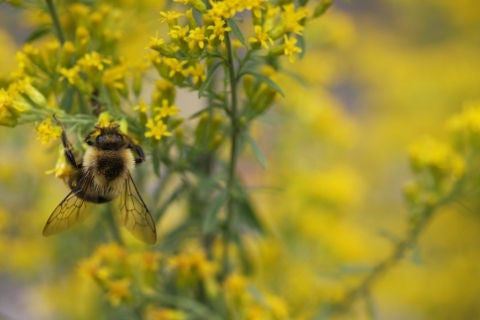
Some thoughtful gardening and a little planning is all it takes to help our native bees. Follow these tips to provide habitat for a diversity of bee species:
- Create a pollinator-friendly garden in a sunny, sheltered spot with a diversity of native flowers that will bloom from early spring through the summer and into the fall. Even a small balcony or patio can be stocked with flowering container plants.
- To attract bees, choose blue, yellow and purple flowers.
- Provide a diversity of flower shapes and sizes. Bees vary in size and have tongues of different lengths. Short-tongued bees need shallow flowers to reach the nectar, while long-tongued bees can access the nectar of deeper flowers.
- A muddy spot will provide nesting materials for some bees.
- Clover in the lawn will supplement food sources in flower beds.
- Avoid pesticides. Refer to CWF’s handout, Natural Insect Control, for better options.
- A lack of nesting sites can seriously limit bee populations. Provide undisturbed, sparsely vegetated, mulch-free soil in warm, well-drained, sandy sites, preferably on a south-facing slope, for ground-nesting bees.
- If you don’t have a sloping spot in the sun, you can create your own by making a mound of sandy soil that is about 60 centimetres high and 1.5 metres wide when tamped down.
- Logs and old stumps in sunny areas are good for bees that nest in cavities.
- Shrubs with pithy stems, such as elderberry, raspberry and sumac, provide nesting sites for small carpenter bees and other species.
- Leave some areas of overgrown grass, hedgerow or abandoned rodent burrows as nesting sites for bumble bees.
- Bees don’t travel far to forage for nectar, so ensure nesting sites are within 250 metres of flower beds.
- Some bees overwinter in plant stems, so it’s a good idea never to cut back an area of shrubs completely.
- Allow some leaf litter to remain in your garden as an overwintering site for bumble bees.






